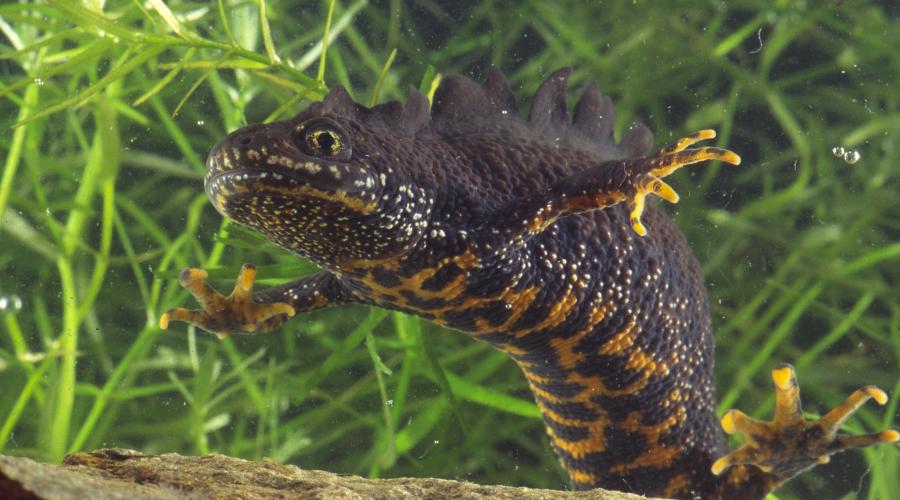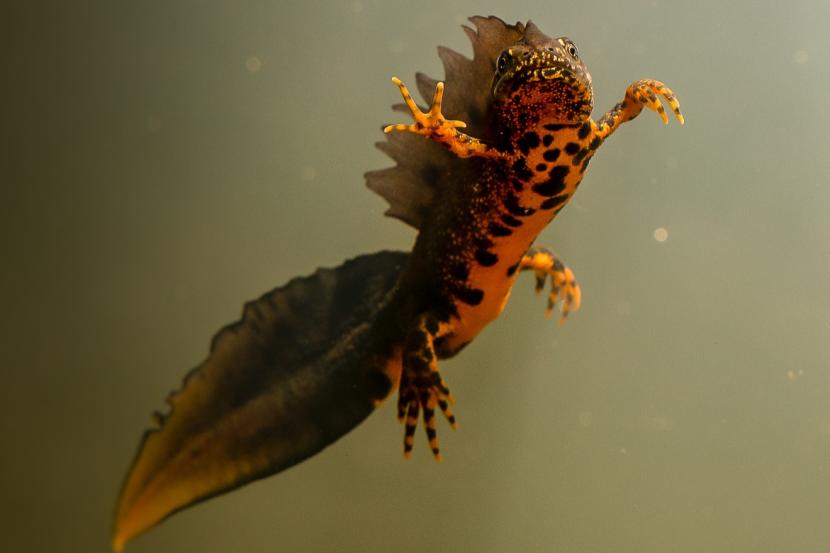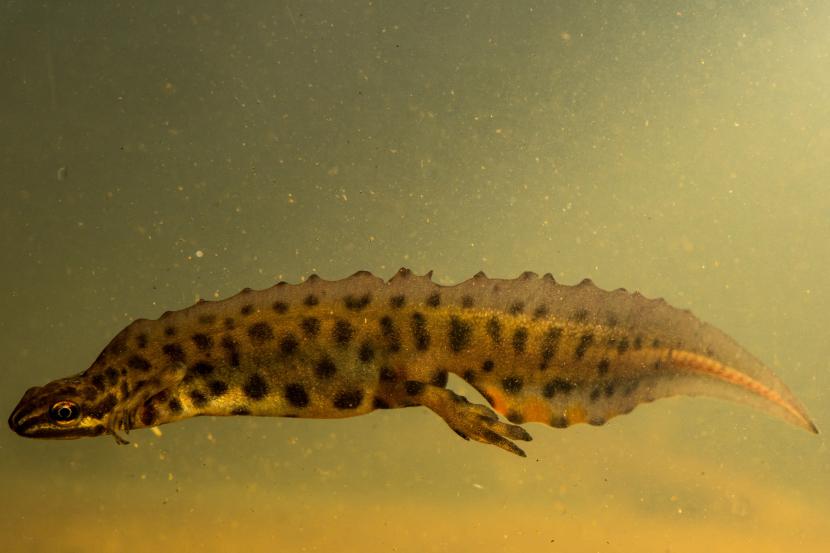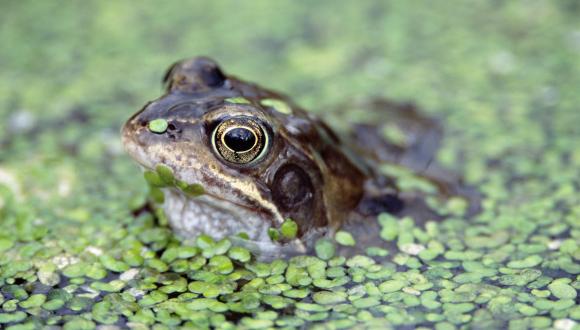
Newts
This species has suffered due to the loss of small ponds from our landscape caused by changes in land management practices.
Great crested newt
The great crested newt (Triturus cristatus) is the largest of Britain’s three newt species, with adults reaching up to 17cm in length.
This amphibian gets its name from the jagged crest along the adult male’s back, which gets larger in the breeding season. Both sexes are very dark in colour, with a vivid orange belly with irregular black spots.
The great crested newt spends most of its life on land, though it must return to small freshwater ponds to breed. This species hunts invertebrates by night, and rests in damp grassland or leaf litter during the day. It usually lives within 250m of a breeding pond.
Rare across Europe but still quite widespread in Britain, the great crested newt is found in Scotland in patches in the rural south and around Inverness. The species also occurs across the central belt, where it’s often under threat from industrial or housing development. This is because the newt has found a niche in former mineral workings and other brownfield habitats.
Breeding takes place in ponds in spring to early summer, when it’s warm enough. A female can lay around 300 eggs, one by one, on vegetation. Larvae usually develop in the pond for three months before moving to land. Once on land, the young take around three years to reach breeding maturity.

Threats to great crested newts
The species has suffered a decline in recent years and is under threat in several European countries. The British great crested newt population is amongst the largest in Europe.
Great crested newts thrive where several ponds within an area are connected by suitable habitat. This means that if one pond becomes unsuitable, others are still available for breeding.
A 1995-96 national survey found 85 ponds in Scotland with great crested newt populations. Subsequent conservation work has brought this number up to around 160 ponds.
Threats to the great crested newt include:
- Loss of breeding ponds through destruction or degradation of water quality
- Introductions of fish to breeding ponds – this is almost always catastrophic as fish will eat newt eggs and juveniles (as well as those of other amphibian species)
- Loss and fragmentation of terrestrial habitat
- The natural process of succession in which the pond, through time, fills with vegetation and silt and so dries out
Protection of great crested newts
The great crested newt is a European protected species.
Find out about protected species of amphibian and reptile.
Learn about licensing for great crested newts and natterjack toads.
Palmate newt

Palmate newts (Lissotriton helveticus) are found all over Scotland, including many of the islands, and at higher altitudes.
They can be found in a wide range of habitats such as woodland, heaths, grasslands, agricultural land, and urban areas.
The colour of individuals can vary between olive green, dark brown, with dark spots. They can be most easily distinguished from smooth newts by the presence of a pink, translucent throat. In their terrestrial stage, they have a yellow stripe down the back which continues down the tail.
Juvenile newts are aquatic with frilly external gills. These gills will be absorbed, and they will then leave the water and become terrestrial. They will then return to the water to mate during the breeding season.
Juveniles and aquatic adults will feed on zooplankton, Daphnia, frogspawn, and tadpoles, and terrestrial adults will eat slugs, springtails, and other small land invertebrates.
Smooth newt

Smooth newts (Lissotriton vulgaris) are predominantly found in southern Scotland, with a few populations in the west of the country and the Highlands.
They can be found in lowland agricultural and urban areas, but are typically absent in areas of higher acidity, such as moors and mosses.
Smooth newts possess spotting on the belly, back, and throat, with breeding males developing a prominent dorsal crest. They can be most easily distinguished from palmate newts by the lack of a pink, translucent throat. In their terrestrial stage, they have a yellow stripe down the back which fades.
Juvenile newts are aquatic with frilly external gills. These gills will be absorbed, and they will then leave the water and become terrestrial. They will then return to the water to mate during the breeding season.
Juveniles and aquatic adults will feed on zooplankton, Daphnia, frogspawn, and tadpoles, and terrestrial adults will eat slugs, springtails, and other small land invertebrates.
Report a sighting
You should report any sighting of an amphibian or reptile to the Record Pool.
Alternatively, find out about taking part in the National Amphibian and Reptile Recording Scheme.
How can you help?
Reptiles and amphibians are both threatened groups, so it is important that we make space for these important creatures where we can. Here are some tips for ways that you could help:
- You could consider the addition of a pond to your garden to create more habitat, or encourage the growth of bug friendly plants to ensure a plentiful food supply.
- Using non-toxic methods of pest management will prevent reptiles from consuming prey that are contaminated with poison.
- Ensure that green spaces are preserved and kept as wild as possible.
- Record any reptile or amphibian sightings to the Record Pool and the NBN atlas.
- Get involved with your local amphibian and reptile group. There may even be opportunities for you to help with monitoring and surveying, or even trips to local sites!
- Help raise awareness about reptile and amphibian conservation within your school or workplace.
Further resources
For information regarding the legislation that protects our reptiles and amphibians, see Protected Species: amphibians and reptiles
For a comprehensive overview of the reptiles and amphibians of Scotland, see the book ‘The Amphibians and Reptiles of Scotland’ by Chris McInerny and Pete Minting.
For free online ID guides regarding British amphibians and reptiles, please refer to the ARG UK website.
Find out how you can take part in the National Amphibian and Reptile Monitoring Programme.
To find your local reptile and amphibian interest group, as well as additional resources, see the ARG UK website.







